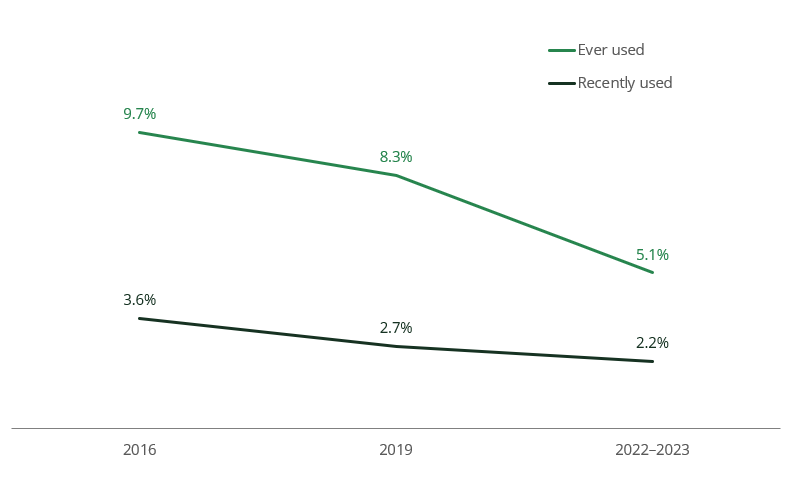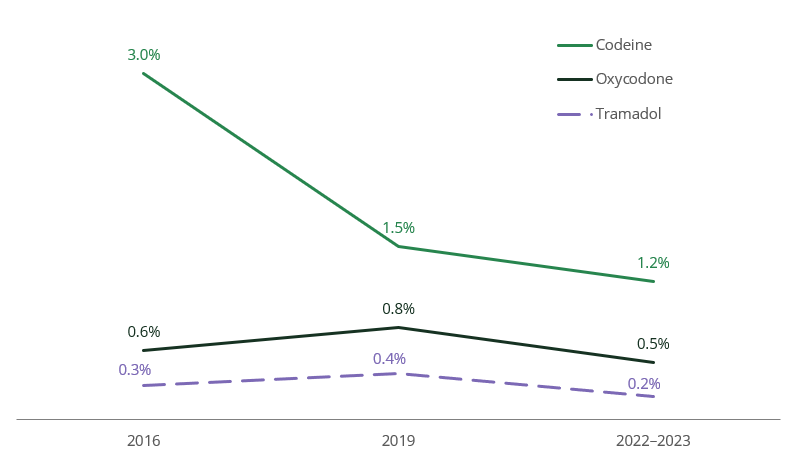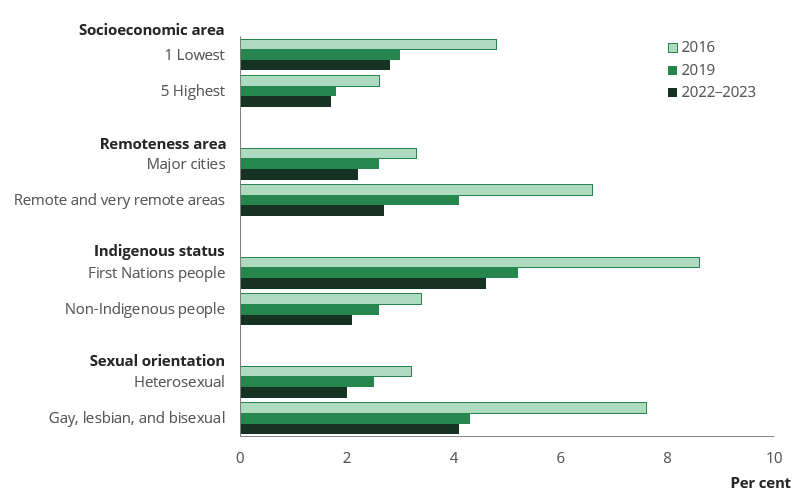Table 1: Summary of non-medical use of pain-relievers and opioids by people aged 14 and over in 2022–2023Lifetime use | 5.1% (1.1 million people) |
|---|
Recent use1 | 2.2% (500,000 people) |
|---|
Change since 2019 | ⬇ Lifetime use (8.3%) ⬇ Recent use (2.7%) |
|---|
Change since 2016 | ⬇ Lifetime use (9.7%) ⬇ Recent use (3.6%) |
|---|
Age group most likely to use | 14–19 (2.7%) |
|---|
Average age of first use | 23.5 years |
|---|
Table 2: Summary of non-medical use of pain-relievers and opioids by people who had recently used them in 2022–2023Used monthly or more often | 36% |
|---|
Main type used | Codeine: 71% (2019: 61%) |
|---|
Diagnosed or treated for a mental health condition | 32% |
|---|
High and Very high psychological distress | 35% |
|---|
1. Refers to use of pain-relievers and opioids for non‑medical purposes in the previous 12 months.
Source: NDSHS 2022–2023.
Fewer people using pain-killers/pain-relievers and opioids for non‑medical purposes
Non‑medical use of pain-relievers
In the NDSHS, non‑medical use refers to using the drug for recreational purposes (to induce or enhance a drug experience) and using a drug in a way that it was not prescribed/recommended (for example, using it to enhance a drug experience, for weight loss or performance enhancement).
All results in this article refer to the use of pain-killers/pain-relievers and opioids (collectively called ‘pain-relievers’) for non‑medical purposes, and does not include medical use of these drugs. This does not include the use of paracetamol, aspirin and ibuprofen where these drugs are the only active ingredients.
In 2022–2023, 500,000 people in Australia (2.2% of the population) had used pain-relievers for non‑medical purposes in the previous 12 months. This continues the downward trend since 2016, when 3.6% of the population had done so (Figure 1).

Source: NDSHS 2022–2023, Tables 6.1 and 6.2.
This reduction in use was driven almost entirely by males. In 2019, 3.0% of males had used pain-relievers for non‑medical purposes in the previous 12 months, compared with 2.4% of females. In 2022–2023, males (2.1%) and females (2.2%) had similar rates of use.
Despite these reductions, there has been an emergence of young people using these drugs for non‑medical purposes. There was a threefold increase in the non‑medical use of pain-relievers among people aged 14–19 between 2019 (*0.9%) and 2022–2023 (2.7%). This increase was driven predominantly by females aged 14–19, with *4.0% having recently done so in 2022–2023.
* Estimate has a relative standard error between 25% and 50% and should be interpreted with caution.
While proportions for young people may vary year-to-year due to a small sample size, these increases in 2022–2023 were meaningful and may indicate a growing area of concern. This also reflected a general trend in increasing use of licit and illicit drugs among young females.
Reductions in use of most opioids, but gabapentin and pregabalin increase
Changes to codeine scheduling
In February 2018, medications containing codeine were reclassified to schedule 4 drugs, meaning they could no longer be purchased from a pharmacy or chemist without a prescription. Changes occurred in the proportion of people using codeine non‑medically in the 2019 National Drug Strategy Household Survey (AIHW 2020) and reductions are continuing in 2022–2023.
Codeine (1.2%) and oxycodone (0.5%) remained the most commonly used pain-relievers for non‑medical purposes nationally, although use of both had decreased since 2019 (Figure 2). These are historically the most dispensed opioids in Australia, although the amounts of codeine and oxycodone being dispensed have also decreased since 2019–20 (AIHW 2023).
Non‑medical use of tramadol (the third-most prescribed opioid) decreased, halving between 2019 (0.4%) and 2022–2023 (0.2%).

Source: NDSHS 2022–2023, Table 6.11.
While prevalence of non‑medical use of gabapentinoids (gabapentin and pregabalin) was low in 2022–2023 (0.2% of the population), early signs of an increase in use did occur. Among those who had used pain-relievers for non‑medical purposes, 9.3% had used one of these drugs, more than double the proportion in 2019 (4.3%).
Who is most likely to use pain-relievers for non‑medical purposes?
As with all illicit drugs, non‑medical use of pain-relievers was not uniform across the Australian population in 2022–2023 (Figure 3).

Note: Rates for First Nations people should not be directly compared to rates for non‑Indigenous people due to differences in the age structures between the two populations. Age standardised results can be found in the supplementary data tables.
Source: NDSHS 2022–2023, Table 6.15.
People living in the most disadvantaged socioeconomic areas were more likely to have used pain-relievers for non‑medical purposes than those living in other socioeconomic areas. This was consistent with results from 2019, but different patterns to other illicit drugs. In 2022–2023, people living in the most disadvantaged socioeconomic areas were:
- 1.6 times as likely to have used pain-relievers for non‑medical purposes.
In contrast, people living in the most advantaged areas were:
- 2.7 times as likely to have used pharmaceutical stimulants for non‑medical purposes.
- 1.2 times as likely to have used either methamphetamine and amphetamine or any illicit drug.
- 1.2 times as likely to have used any illicit drug.
The reductions over time in non‑medical use of pain-relievers at the national level were also reflected in other social characteristic groups, but differences between populations were still present in 2022–2023 (Figure 3):
- Under 1 in 20 (*4.6%) Aboriginal and Torres Strait Islander (First Nations) people had used pain-relievers and opioids for non‑medical purposes in the previous 12 months. After adjusting for differences in age, First Nations people were 2.2 times as likely to have done so as non‑Indigenous people (down from 2.5 times as likely in 2016).
- Under 1 in 20 (4.1%) gay, lesbian, and bisexual people had used pain-relievers and opioids for non-medical purposes in the previous 12 months. After adjusting for differences in age, gay, lesbian and bisexual people were 2.5 times as likely to have done so as heterosexual people.
- People living in Remote and Very remote were 1.2 times as likely to have used them as those in Major cities (down from 2.0 times as likely in 2016).
* Estimate has a relative standard error between 25% and 50% and should be interpreted with caution.


